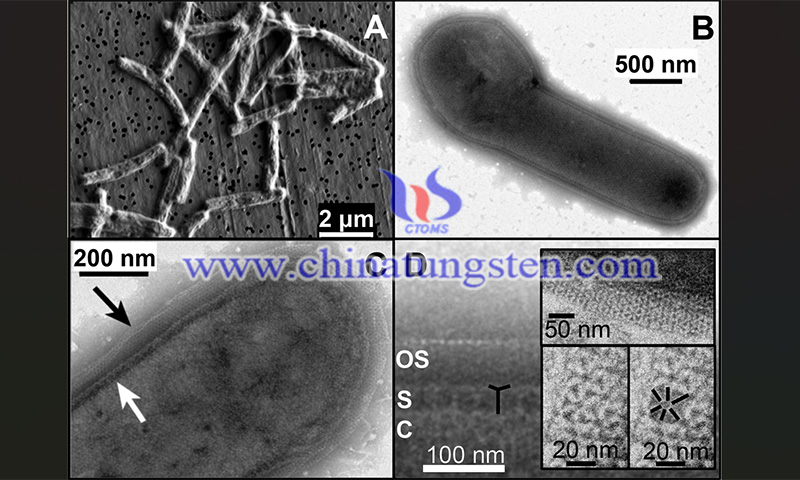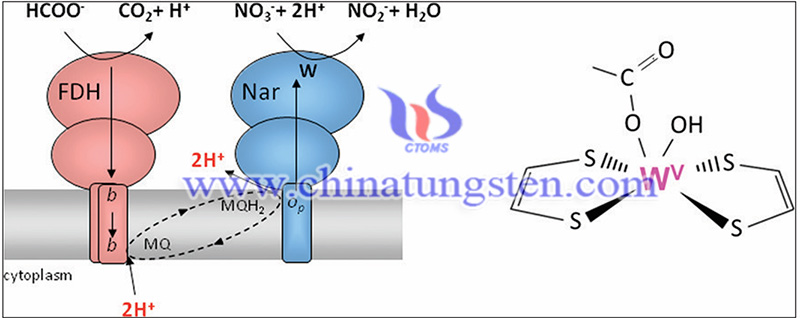Effect of Tungstate on Nitrate Reduction by Pyrobaculum aerophilum
- Details
- Category: Tungsten Information
- Published on Tuesday, 05 April 2022 19:06
Researchers at the University of California have conducted a study on the effect of tungstate on nitrate reduction in Pyrobaculum aerophilum, a hyperthermophilic archaeon that can respire both at low levels of oxygen and anaerobically with nitrate as the electron acceptor. Under anaerobic growth conditions, nitrate is reduced to molecular nitrogen via the denitrification pathway.
The study titled “Effect of Tungstate on Nitrate Reduction by the Hyperthermophilic Archaeon Pyrobaculum aerophilum” has been published in the journal Applied and Environmental Microbiology (64). The study was carried out by Sepideh Afshar at the University of California.
This study shows that thermophilic bacteria require the metal oxygen ion WO42- for their anaerobic growth on yeast extract, peptone and nitrate as carbon and energy sources. The addition of 1 μM MoO42- did not replace WO42- to promote the growth of thermophilic bacteria.
However, cell growth was completely inhibited by the addition of 100 μM MoO42- to the medium. At lower tungstate concentrations (0.3 μM and below), nitrite accumulated in the medium. At higher WO42- concentrations (<0. 7 μM), the accumulation of nitrite was counteracted.

High-temperature enzyme assays were performed for nitrate, nitrite, and nitric oxide reductase. Most of the activities of all three enzymes of the denitrification pathway were localized to the cytoplasmic membrane, indicating their involvement in cellular energy metabolism.
This study documents the first example of the effect of tungstate on the denitrification process in an extremely thermophilic archaeon. It is demonstrated that the synthesis of nitrate reductase in Pyrobaculum aerophilum occurs in the presence of high concentrations of wolframate.
However, the addition of wolframate to the medium resulted in a significant improvement in growth yield or the activity of certain enzymes. The role of tungsten in biological systems and the properties of tungsten enzymes were recently studied by researchers.
Pyrobaculum aerophilum grows at an optimum temperature of 100°C. Unlike its strictly anaerobic, sulfur-reducing relatives, P. aerophilum uses nitrate and low partial pressure oxygen (0.6 to 1% O2 in the gas phase) as electron acceptors for growth, and its nitrate reduction proceeds via the denitrification pathway.
To investigate the possible effect of tungstate on the ability of thermophilic bacteria to respire anaerobically with nitrate, the researchers conducted growth studies using different concentrations. Increasing the amount of wolframate in thermophilic bacteria resulted in a decrease in their nitrate reductase specific activity, suggesting that this enzyme may be a molybdenum-containing nitrate reductase.
Thus, the ability of S. thermophilus to respire with nitrate at high tungsten levels may reflect the adaptation of this organism to high tungsten environments through an as yet unknown mechanism.

In cells grown at low wolframate concentrations, the increase in nitrite reductase activity was consistent with an accumulation of nitrite in the culture medium. This accumulation of nitrite is not due to the absence or reduced levels of nitrite reductase under these conditions, as the activity of nitrite reductase is constant in cells grown at different concentrations.
The nitrite reductase of thermophilic bacteria has been shown to inhibit both substrate and end products and is therefore considered to be the rate-limiting step in the denitrification pathway. Whether tungstate somehow regulates the activity or synthesis of enzymes of the denitrification pathway in thermophilic bacteria is unclear, and studies are ongoing.
- Tungsten Manufacturer & Supplier, Chinatungsten Online: www.chinatungsten.com
- Tungsten News & Prices of China Tungsten Industry Association: www.ctia.com.cn
- Molybdenum News & Price: news.molybdenum.com.cn
- Tel.: 86 592 5129696; Fax: 86 592 5129797; Email: sales@chinatungsten.com



 sales@chinatungsten.com
sales@chinatungsten.com